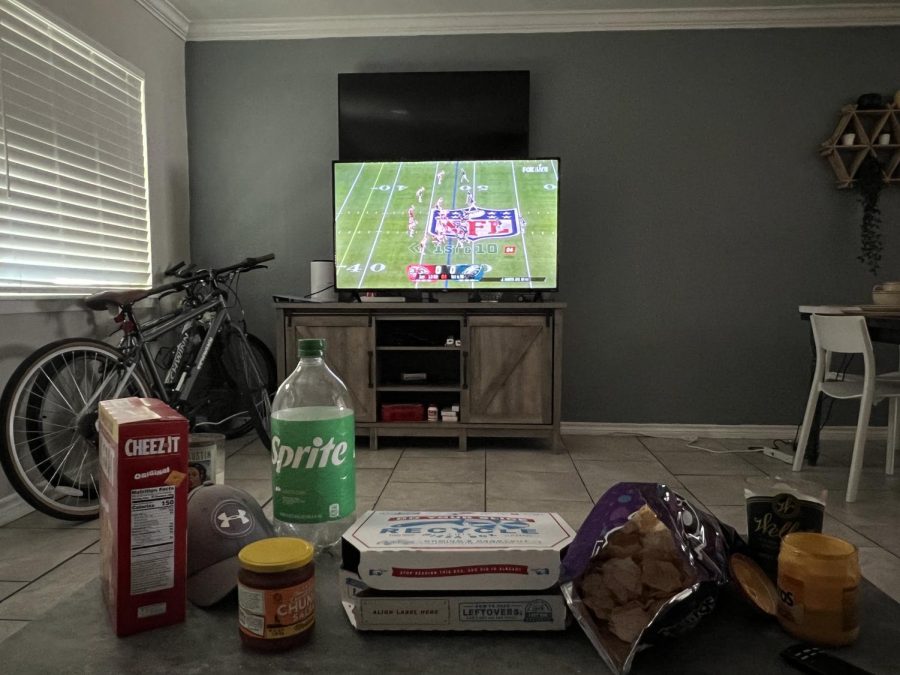College life lowers televised event viewership
How students navigate the effects college life has on their TV-watching habits
With the beginning of every year comes a new television award season. People across America will be, and have been, tuning in to watch their Super Bowl champion, Album of the Year and Best Picture winners be awarded. Typically, these televised events are easily accessible for those wanting to watch, but for college students away from home, another challenge arises. What used to be a short walk to the living room for Sunday night football could now mean a trek to an upper campus projector.
Three of the largest media events on television all occur around this time. Recently, people across the United States gathered to watch the Grammys (Feb. 5) and the Super Bowl (Feb. 12), and will just as soon be sitting down for the Oscars (March 12).
The target audience for these televised events is largely the college-age and older demographics, with the majority of nominees and advertisements being relevant to those generations. Despite this, the percentage of college students watching has seen a decline in recent years. Jon Lewis, sports media journalist, compiled statistics for his sports media website for the past decade of Super Bowl viewerships. He explained that the viewership with adults ages 18-49 has been declining over the past eight years.
This decline in college age viewers can be attributed largely to the lifestyle adjustments university life brings. Gaby Wehrung, junior neuroscience major, expressed that she has watched fewer televised events since coming to college.
“Classes and other commitments have limited my free time to the extent that I watch much less than I used to at home or in high school. Any free time I have now is typically taken up by completing homework, other assignments or studying for class/exams,” Wehrung said.
This drop in viewership shows that college-aged people are increasingly less likely to tune into the next nationally televised mega-event due to the college lifestyle. However, some students on campus share that this is not due to disinterest but inaccessibility.
Vivien Allen, first-year engineering major, is now over a four-hour drive away from her home. Her home traditions regarding different televised events have shifted to adjust to this change.
“I love all of the social changes college has brought, but I do really miss how easy it was being able to stay home on a Sunday to watch football with my dad,” Allen said.
Many students find themselves in a similar predicament surrounding the accessibility of televised events away from home. They want to watch but find it hard to do so.
“I used to try to tune into all of the big events for at least part of the time, but the college environment has definitely changed that,” Allen said. “I have less time due to work and friends wanting to go do other things, and with the barrier of not having an easy way to watch, my watch time has definitely decreased.”
College life often leaves students with constantly changing schedules after classes, so late-night viewings are often the most accessible option for students trying to get a group together to watch an event. Even though the timing of these events is convenient, having a television on campus and a roommate willing to host a large group is a new obstacle.
“It is a bit harder not having my own TV on campus. In order to watch an event, I have to drive to an upperclassman off-campus apartment,” Allen said. “It does create this kind of barrier as I have to take unnecessary extra steps in order to maintain a tradition.”
Although some students with access to cars on campus have found it easier to navigate this change, others have had to find some on-campus alternatives to keep up with televised events.
Paulina Warner, first-year engineering major, shares a similar sentiment regarding the effects of college on her typical watching habits, but she has been able to find some alternatives on campus.
“I have a monitor in my room but I don’t have comfortable seating, so using the facilities on campus is really helpful. In the past, I have used the projectors in CSI [Center for the Sciences and Innovation] to watch movies or shows with my friends,” Warner said.
There are several desktops, projectors and televisions located throughout the CSI. Most of the technology in the building is open to student use. With the right HDMI cable or cell phone adapter, anyone can connect to an overhead projector in a classroom or a television in the Cube area to stream their event of choice.
Furthermore, several of the dorm buildings on campus have common areas with televisions for student use. However, these are often smaller spaces and typically can only support one group.
Though more limited in size, there are many spots like this littered around campus. Any student wanting somewhere to keep up with televised events on campus does not need to look any further than their own residence hall or an upper campus classroom.

I am a senior photographer from Houston, Texas majoring in Biology on the pre-PA track. I love sports photography and just being able to capture a moment...







